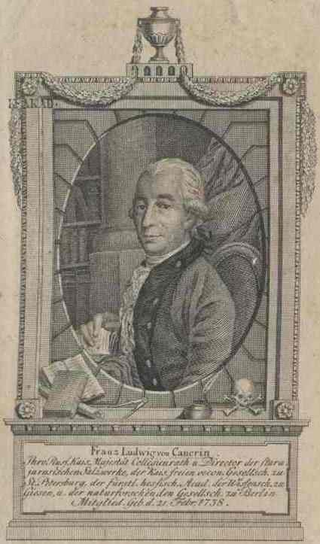Related Research Articles

Ernst Klee was a German journalist and author. As a writer on Germany's history, he was best known for his exposure and documentation of medical crimes in Nazi Germany, much of which was concerned with the Action T4 or involuntary euthanasia program. He is the author of "The Good Old Days": The Holocaust Through the Eyes of the Perpetrators and Bystanders first published in the English translation in 1991.

Franz Ludwig von Cancrin was a German mineralogist, metallurgist, architect and writer.

Christoph Meckel was a German author and graphic artist. He received awards for his works which connect illustrations with the written text, sometimes texts by others.

Franz Kessler was a portrait painter, scholar, inventor and alchemist living in the Holy Roman Empire during the 16th and 17th centuries.

Ireen Sheer is a German-English singer. She had her first major hit in 1970 with Hey Pleasure Man. She had a top five hit on the German singles chart with "Goodbye Mama" in 1973. She went on to finish fourth at the Eurovision Song Contest 1974 representing Luxembourg, sixth at the Eurovision Song Contest 1978 representing Germany, and thirteenth at the Eurovision Song Contest 1985 representing Luxembourg again.
Nicolaus A. Huber is a German composer.

Johann Christoph Volkamer was a German merchant, manufacturer and botanist.
Hermann Karl Lenz was a German writer of poetry, stories, and novels. A major part of his work is a series of nine semi-autobiographical novels centring on his alter ego "Eugen Rapp", a cycle that is also known as the Schwäbische Chronik.
Volkslied is a genre of popular songs in German which are traditionally sung. While many of them were first passed orally, several collections were published from the late 18th century. Later, some popular songs were also included in this classification.
Wolfgang Weyrauch was a German writer, journalist, and actor. He wrote under the pseudonym name Joseph Scherer.

Alice Rühle-Gerstel was a German-Jewish writer, feminist, and psychologist.

Kurt Flasch is a German philosopher, who works mainly as a historian of medieval thought and of late antiquity. Flasch was professor at the Ruhr University Bochum. He was / is a member of several German and international Academies. In 2000, he was awarded the Sigmund Freud Prize by the Deutsche Akademie für Sprache und Dichtung.

Helmut Müller-Enbergs is a German political scientist who has written extensively on the Stasi and related aspects of the German Democratic Republic's history.
The Deutsche Theatrum Chemicum is a collection of alchemical texts, predominantly in German translation, which was published in Nuremberg in three volumes by Friedrich Roth-Scholtz (1687–1736), the publisher, printer and bibliographer.

Gerhard Zwerenz was a German writer and politician. From 1994 until 1998 he was a member of the Bundestag for the Party of Democratic Socialism (PDS).

Eveline Lemke is former German politician and member of the Alliance 90/The Greens. From 18 May 2011 until 18 May 2016, she was vice minister president of Rhineland-Palatinate and Minister for Economics, Climate Protection, Energy and Regional Planning. On 27 March 2011, she was elected into the Landtag of Rhineland-Palatinate. She was the leading candidate for her party in the 2016 Rhineland-Palatinate state elections along with The Greens faction leader in the Landtag, Daniel Köbler, after having been leader of the party since 2006. As vice minister Lemke represented the state of Rhineland-Palatinate in the German Bundesrat. As author and speaker in green technological issues and Circular Economy, she founded Thinking Circular in 2017. This thinktank is listed in the Sustainable Development Goals Help Desk, a platform by the United Nations since July 2018. She is also working as consultant together with Prof. Michael Braungart, chemist and inventor of the design philosophy Cradle-to-Cradle, Martin Lees and David Wortmann (DWR-Eco-Innovation-Alliance).

Johannes Praetorius was a German writer and historian.

The Sarıaydın inscription is an Aramaic inscription found in situ in 1892 near the village of Sarıaydın in Southern Anatolia. It is also known as the Sarıaydın Hunting inscription or the Cilician Hunting inscription. It was discovered on the Austrian expedition to Cilicia of Rudolf Heberdey and Adolf Wilhelm.
References
- ↑ Bernhard Kreuz, Petra Aigner, and Christine Harrauer (2009), Bibliographie zum Nachleben des antiken Mythos. Online report by the Austrian Academy of Sciences. Accessed on 2009-12-30.